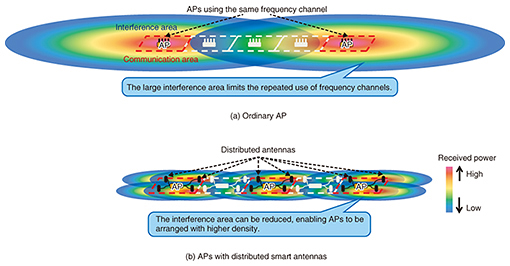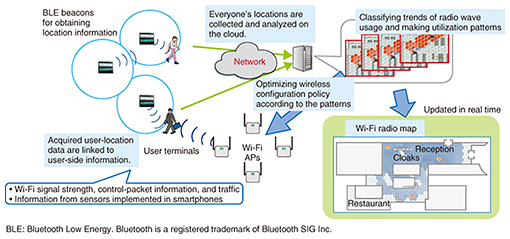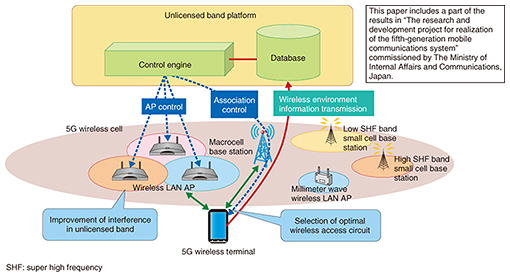 |
|||||||||||||||||||||||||||
|
|
|||||||||||||||||||||||||||
|
Feature Articles: NTT Tsukuba Forum 2016 Workshop Lectures Vol. 15, No. 4, pp. 42–49, Apr. 2017. https://doi.org/10.53829/ntr201704fa6  Wireless Access Technologies to Enable a Variety of ServicesAbstractIn the wireless access project at NTT Access Network Service Systems Laboratories, we are researching and developing wireless access technologies centered around wireless local area network (LAN) technology. This article describes the issues that have arisen due to the growing use of wireless LANs and introduces our research and development efforts aimed at solving these issues and expanding the use cases of wireless LANs. Keywords: cooperative wireless LAN, unlicensed radio, fifth-generation mobile 1. IntroductionWireless local area networks (LANs), or Wi-Fi*1 networks, are gaining much attention due to the rapid growth in the number of user devices including smartphones and tablets being used in homes and offices. It was reported that in 2016, over 50 million user devices equipped with wireless LAN functions were sold in Japan [1]. Access points (APs) are also being installed to handle the increasing traffic in mobile networks, and the number of users of public wireless LAN services is increasing. One of the factors behind the spread of wireless LANs is that they operate on the unlicensed frequency band, which has made it possible for users to install their own equipment for as little as $100 or so. To provide this feature, the wireless LAN standard IEEE*2 802.11 was established in 1997 as the first to use wireless access control methods with autonomous distributed control, which is called carrier sense multiple access with collision avoidance (CSMA/CA). The maximum transmission speed of this initial standard was 2 Mbit/s, but that has risen 1000-fold in just under 20 years, where the products compliant with the latest IEEE 802.11ac standard have a maximum speed of 1.7 Gbit/s (Fig. 1). Throughout this time, CSMA/CA has remained the basic wireless access control method, allowing for backward compatibility with earlier wireless LAN equipment.
CSMA/CA is a mechanism that allows multiple wireless devices to share the same frequency channel [2]. Instead of having a centralized controller to control the access of each device as in the mobile phone system, in CSMA/CA the wireless APs and user devices perform autonomous distributed channel access before their radio emissions so as not to interfere with those of other devices. Specifically, this method carries out transmission after ensuring there are no radio waves from other terminals (carrier sense) and pausing for a prescribed random interval. It thus avoids interference with the radio transmissions of other terminals (collision avoidance), enabling multiple devices to share the same frequency channel (multiple access). Centralized access control methods are effective in systems where each licensed operator occupies and uses a different set of frequencies, but with unlicensed wireless access, autonomous distributed control is necessary in order for radio waves to be shared by the devices of different owners.
2. Issues of wireless LAN technologyDespite the popularity and convenience of wireless LANs, there has been an increase in the problems caused by excessive numbers of users. In an environment where many wireless LANs are used in close proximity to one another, it is harder to secure transmission opportunities in the CSMA/CA protocol, resulting in a higher incidence of packet errors due to collisions. Problems are also caused by congestion of wireless channels caused by the exchange of management signals such as beacon signals that are periodically transmitted by wireless APs, and probe signals that are used by terminals searching for a wireless AP to connect to. This can make it impossible to make proper use of wireless LANs in busy places such as train stations where many people would like to use them. As Japan prepares for the major events in 2020, there are growing expectations for the provision of entertainment services using wireless LANs in stadiums. However, with the current wireless LAN technology, a stadium is an even more difficult environment than a train station. When providing high-bandwidth content such as videos to large numbers of spectators in a stadium, it is possible to increase the traffic capacity to some extent by installing wireless APs more densely, but the traffic capacity does not rise in proportion to the number of installed APs. In a stadium, the line of sight between the spectator seats is particularly good, and it is usually possible for radio waves from a wireless LAN installed in the back stands to be received in the main stands. In this sort of environment, many wireless APs have to contend for the same frequency channel, resulting in lower traffic capacity per wireless AP. Development of the fifth-generation mobile communications system (5G) is underway worldwide as part of efforts to exploit the expected commercial opportunities that will arise in 2020. Mobile traffic is continuing to grow due to the increasing use of smartphones and advances in mobile applications. Although the rate of increase has eased lately, it is still growing by a factor of 1.4 every year according to a recent report [3], and it is expected that the amount of traffic in 2020 could be about a thousand times greater than in 2010. To accommodate this traffic, 5G technologies that use a combination of diverse wireless access techniques, including the use of new frequency bands, are being researched and developed, and it is expected that wireless LANs and other unlicensed wireless technologies will also be used as a way of supporting 5G traffic [4]. At the Radio Policy Vision Council that met in December 2014, the Ministry of Internal Affairs and Communications resolved to secure a frequency bandwidth in the 2700-MHz range for mobile communication systems by 2020, with the assumption that mobile frequencies will be integrated with the frequencies used for wireless LANs [5]. However, as mentioned above, wireless LANs using unlicensed frequencies suffer from poor throughput in congested radio environments. Consequently, improving the characteristics in congested environments is a major challenge in order to accommodate mobile traffic in unlicensed bands. 3. Development of wireless LAN technology at NTTIn order to implement 5G services in time for the big events of 2020, further evolution of wireless LAN is expected. To respond to these needs, we must ensure that service quality is maintained even in environments where wireless APs and terminals are packed closely together. One way of minimizing the deterioration of wireless LAN quality in high density environments without damaging the ease of access to ordinary users to wireless LAN services is to continue using the CSMA/CA distributed access control method while optimizing wireless resources such as the transmission power and the number and bandwidth of wireless channels. The current wireless APs generally choose wireless channels in which there are few interfering APs after observing wireless AP signals in the vicinity, but in environments with high wireless LAN density, APs that are liable to cause interference are themselves subject to interference from other APs. As a result, the wireless environment can become extremely congested. In such circumstances, a complete overhaul of the radio environment is warranted. At NTT laboratories, we are researching and developing an architecture called cooperative wireless LAN, whereby information about the wireless environment is collected from multiple APs, and the parameters of each wireless AP are set appropriately based on this information. Wireless access control is still performed by CSMA/CA autonomous distributed control, while some of the wireless AP parameters are optimized by centralized control in order to improve the overall bandwidth usage efficiency. In May 2014, the IEEE 802.11 Working Group embarked on the standardization of high-efficiency wireless LAN (11ax) as the next generation standard. The technical requirements set by this standard include the provision of an operating mode where the average throughput is at least four times that of a conventional terminal in high-density environments, and work is under way with the aim of implementing this standard by the end of 2018. Although compatibility with high-density environments is thus being promoted for standard technology, the range of parameters that can be set according to diverse needs in the 11ax standard is becoming broader, and we believe that wireless AP control would work more effectively in a cooperative wireless LAN. NTT is actively participating in the 11ax standardization process by promoting the implementation of standards that are suitable for cooperative wireless LAN configurations, and leading in the development of 11ax-compatible radio resource control techniques. 4. Efforts aimed at implementing a cooperative wireless LAN platformIt is thought that a cooperative wireless LAN architecture, where some of the wireless AP parameters are controlled centrally from the cloud, could be developed to provide diverse services in addition to wireless resource control functions (Fig. 2). This section introduces a number of techniques that we are working on with the aim of providing a platform with diverse functions obtained by controlling wireless APs.
4.1 Cooperative wireless LAN channel setup techniqueThe configurable wireless resources of an ordinary wireless AP include the wireless channel and channel bandwidth. In 2015, we developed prototype channel configuration software that optimally configures these wireless resources based on wireless environment information collected from multiple wireless APs. This technology uses the collected wireless environment information to construct a virtual wireless LAN environment on a server, and repeatedly tries out different resource settings in this virtual environment in order to converge settings that maximize the predicted throughput performance [6]. We used this technique to perform optimal wireless channel configuration in a free Wi-Fi service at the Tsukuba Forum 2016 event. We also constructed a premium area where specific wireless APs were configured for high-speed communication, enabling us to validate this technique (Fig. 3).
4.2 Cooperative wireless LAN with distributed smart antennasIn environments such as stadiums where wireless LANs are subject to very high-density use, it is not sufficient to simply optimize the wireless channel configuration. Instead, technology is needed to suppress interference more fundamentally. We are therefore developing a cooperative wireless LAN system with distributed smart antennas arranged so that multiple wireless AP antennas are placed close to the user terminals. Since this technique allows communication to take place without scattering radio waves around any more than necessary, it allows frequency channels to be recycled over shorter distances, thereby maximizing the area throughput [7] (Fig. 4). Although distributed smart antenna technology has already started to be introduced into mobile systems, its application to CSMA/CA systems has up until now been considered difficult. The application of distributed smart antennas should make it possible to achieve at least double the overall throughput of a conventional system.
4.3 Wireless LAN service function: radio wave environment visualizationBy making use of the wireless environment information collected by terminals as well as wireless APs, it is possible to perform wireless control that is better suited to the user’s environment. In the future, by analyzing the collective intelligence obtained as wireless environment information from devices that are in regular use, it should be possible to ascertain the status of wireless environments at many different locations in real time, and to promote the efficient use of radio waves. At the NTT R&D Forum held in February 2016, we tested a service based on a reduced set of features from the technology discussed here that created and provided free Wi-Fi signal strength maps using a terminal application provided to visitors. As a result, we confirmed that it was possible to visualize the wireless environment in almost real time [8] (Fig. 5).
4.4 Cooperation between 5G and wireless LANsIn 5G, it is expected that devices will not only be able to switch between wireless LAN connections and mobile circuits as they have been able to do so far, but will also be able to use unlicensed wireless services in close cooperation with mobile networks as a heterogeneous network [5]. The key technologies needed to achieve this are thought to include technologies for ascertaining the quality of unlicensed wireless circuits and controlling wireless resources to reduce interference. Even in unlicensed wireless services where the quality tends to become unstable during high-density use, it will still be possible to select and use services of favorable quality if the service quality can be estimated with high precision [9]. Also, when using wireless resource control to improve the quality of unlicensed wireless services, mobile circuits can be used as control circuits for unlicensed wireless services to perform control using wireless environment information collected from the terminals. This should make it possible to improve the service quality even further [10] (Fig. 6). This paper includes a part of the results in “The research and development project for realization of the fifth-generation mobile communications system” commissioned by The Ministry of Internal Affairs and Communications, Japan [11].
5. Future prospectsWith the growing popularity of inexpensive yet highly convenient commercial products based on IEEE standard technology, wireless LANs have become essential as a means of connecting mobile terminals to networks. However, a growing number of use cases cannot be accommodated with standard technology alone. To meet growing demand with limited radio resources while providing exciting new services, we think that there will be many more situations in the future where our technology will be required. At NTT Access Network Service Systems Laboratories, we will continue developing wireless LAN solutions for ultra-high density environments, and contributing to the realization of reasonably priced 5G services that cooperate with wireless LAN services. References
■Author profileMasato MizoguchiSenior Research Engineer, Supervisor, Project Manager of Wireless Access Systems Project, NTT Access Network Service Systems Laboratories. He received a B.E. and M.E. in electrical engineering from Tokyo University of Science in 1989 and 1991. Since joining NTT in 1991, he has mainly been engaged in R&D of wireless LANs including the IEEE 802.11a systems. He received the Best Paper Award in 2000, 2011, and 2016, and the Achievement Award in 2006 from the Institute of Electronics, Information and Communication Engineers (IEICE). He is a senior member of IEICE and a member of IEEE. |
|||||||||||||||||||||||||||






